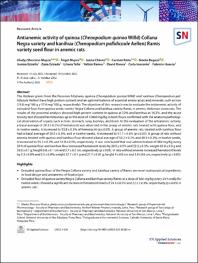Mostrar el registro sencillo del ítem
Antianemic activity of quinoa (Chenopodium quinoa Willd) Collana Negra variety and kanihua (Chenopodium pallidicaule Aellen) Ramis variety seed four in anemic rats
| dc.contributor.author | Moscoso‑Mujica, Gladys | es_ES |
| dc.contributor.author | Mujica, Ángel | es_ES |
| dc.contributor.author | Chávez, Juana | es_ES |
| dc.contributor.author | Peña, Carmen | es_ES |
| dc.contributor.author | Begazo, Noelia | es_ES |
| dc.contributor.author | Estrella, Jumira | es_ES |
| dc.contributor.author | Estrada, Zaira | es_ES |
| dc.contributor.author | Tello, Liliana | es_ES |
| dc.contributor.author | Ramos, Yeltsin | es_ES |
| dc.contributor.author | Rivera, David | es_ES |
| dc.contributor.author | Inocente, Carla | es_ES |
| dc.contributor.author | Huarca, Fabricio | es_ES |
| dc.date.accessioned | 2023-01-27T19:32:04Z | |
| dc.date.available | 2023-01-27T19:32:04Z | |
| dc.date.issued | 2022-10-23 | |
| dc.identifier.uri | https://hdl.handle.net/20.500.13053/7700 | |
| dc.description.abstract | The Andean grains from the Peruvian Altiplano, quinoa (Chenopodium quinoa Willd) and kanihua (Chenopodium pallidicaule Aellen) have high protein content and an optimal balance of essential amino acids and minerals such as iron (19.8 mg/100 g y 17.6 mg/100 g, respectively). The objective of this research was to evaluate the antianemic activity of extruded four from quinoa seeds variety Negra Collana and kanihua variety Ramis in anemic Holtzman strain rats. The results of the proximal analysis showed high protein content in quinoa at 22% and kanihua at 16.2%, and the acute toxicity test showed harmlessness up to the dose of 15000 mg/Kg in both fours confrmed with the anatomopathologi‑ cal observation of organs such as liver, stomach, lung, kidneys, and brain. In the evaluation of the antianemic activity, a basal average of 29.3±0.2% of hematocrit was observed in the group of anemic rats treated with quinoa four, and in twelve weeks, it increased to 53.8±0.3% of hematocrit (p≤0.05). A group of anemic rats treated with kanihua four had a basal average of 29.5±0.3%, and in twelve weeks, it increased to 51.7±0.3% (p≤0.05). A group of rats without anemia treated with quinoa and kanihua four showed a basal average of 50.2±0.2% and 49.3±0.3%; in twelve weeks, it increased to 55.2±0.2% and 54.8±0.1%, respectively. It was concluded that oral administration of 360 mg/Kg every 24 h of quinoa four and kanihua four increased hematocrit levels by 24.5±0.5% and 22.2±0.3%; weight 65.8±0.3 g and 59.2±0.1 g; height 6.8±0.1 cm and 5.7±0.5 cm, respectively (p≤0.05). In rats without anemia increased hematocrit levels by 5.3±0.0% and 5.5±0.0%; weight 37.7±0.1 g and 21.7±0.05 g; height 4±0.0 cm and 3.9±0.0 cm, respectively (p≤0.05). | es_ES |
| dc.format | application/pdf | es_ES |
| dc.language.iso | eng | es_ES |
| dc.publisher | Springer Nature | es_ES |
| dc.rights | info:eu-repo/semantics/openAccess | es_ES |
| dc.rights.uri | https://creativecommons.org/licenses/by/4.0/ | es_ES |
| dc.subject | Chenopodium quinoa Willd · Chenopodium pallidicaule Aellen · Anemia · Antianemic activity · Hematocrit | es_ES |
| dc.title | Antianemic activity of quinoa (Chenopodium quinoa Willd) Collana Negra variety and kanihua (Chenopodium pallidicaule Aellen) Ramis variety seed four in anemic rats | es_ES |
| dc.type | info:eu-repo/semantics/article | es_ES |
| dc.identifier.doi | | https://doi.org/10.1007/s42452-022-05202-w | es_ES |
| dc.type.version | info:eu-repo/semantics/publishedVersion | es_ES |
| dc.publisher.country | SG | es_ES |
| dc.subject.ocde | http://purl.org/pe-repo/ocde/ford#3.03.00 | es_ES |
Ficheros en el ítem
Este ítem aparece en la(s) siguiente(s) colección(ones)
-
SCOPUS [381]


